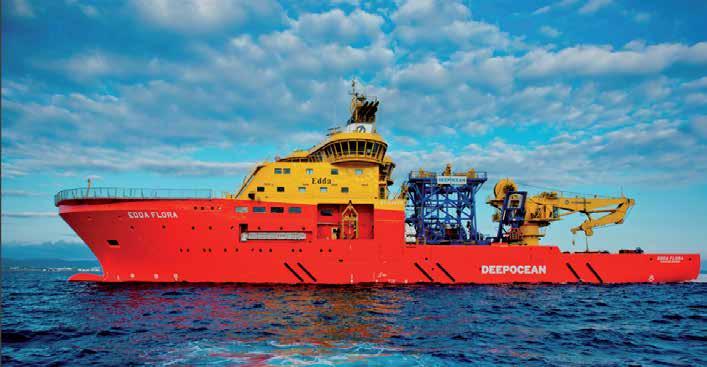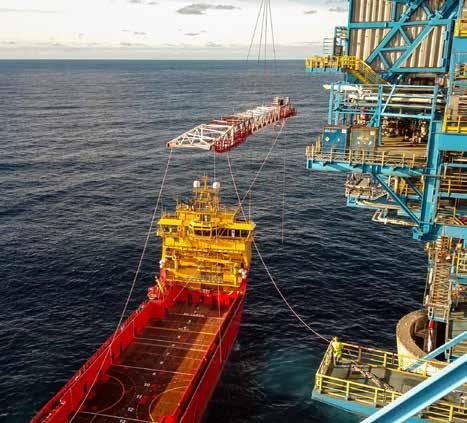
4 minute read
Edda Fauna and Edda Flora install batteries
BILDE AV SKARE
+ FOTO FAUNA OG FLORA
Advertisement
Edda Fauna goes green.
Edda Fauna and Edda Flora will become greener and more attractive to an offshore market reaching for reduced emissions.
Both vessels are going through something of a midlife improvement to increase their competitiveness in today’s market and in the future second-hand market. The company’s policy is to operate the vessels for 20-25 years. - In this case it makes sense to install batteries as a part of the ships’ energy systems, says leader of the project department, Egil Arne Skare. The goal is to implement it in a way that retains their available main deck space. - That’s what makes this a challenge. We can’t just place a container on deck, like you often do on a PSV. On Edda Fauna and Edda Flora, a solution like that would reduce its operability, so the batteries have to be installed below deck. We can’t allow an installation like this to reduce the capacity for our clients, he explains.
PROJECT STARTS AFTER NEW YEARS
- We’ve been speaking to different suppliers about the technology, and have landed on Wärtsilä Norway from Stord as our supplier. They have developed the package we need. The installation will be performed on both ships simultaneously at Westcon Yards. It’s a comprehensive job that will be completed after New Years, when the ships are scheduled for planned maintenance. - Wärtsilä is an integrator; in addition to the battery systems, they also deliver the control systems for the power electronics. This is going to be upgraded and integrated with the DP-system delivered by Kongsberg. The batteries are bought externally. - And the integration of batteries won’t lower the ships’ effectiveness? - No, they’ll be dimensioned for the performance demanded of them, says Skare. He points out that this is all part of a green shift that other Norwegian shipping companies have done before them, and that Østensjø now are ready to go through with, even upgrading ships built when this kind of technology was not available.
Edda Flora will be more attractive with battery technology

- For us in the project department, this has been a creative process where we’ve paid close attention to developing technologies. We have held back a little, but now our opinion is that the technology has matured enough for us to take advantage of it without taking big technical risks.
10 PERCENT IN TOTAL
- What effect will these installations have on the climate? - Depending on wind and weather, the fossil fuel reduction when operating on site will be between 20-30 percent. When the vessels sail from A to B, the savings are equal to zero. In other words, we’re not talking about a constant reduction, but about 10 percent in total, depending on how long they’re sailing for, and how long they’re idle. Diesel is still the main energy source, but if they utilise the batteries when in operation on site, the effect will be noticeable. When on site, the ships prepare for the job and engage a battery instead of a diesel engine. Which means you only need one diesel engine running instead of two or three.
HYDROGEN UNDERWAY
- In your opinion, how long until vessels like these are completely battery-driven? Can it realistically happen? - A hundred percent battery operations won’t happen. For these types of vessels, hydrogen operations could happen within ten years. I think that already within five years, hydrogen will be utilised on the new vessels we’re building for the offshore wind farms. I’ll be surprised if we’ve not managed to perfectly combine hydrogen/battery operations by then.
ONSHORE POWER SUPPLY ON THREE VESSELS
- At the same time, Edda Fauna and Edda Flora will be upgraded to take advantage of onshore power supply? - Yes, that’s a part of the upgrades we’re making for Edda Fauna and Edda Flora, and Edda Ferd, as well. We’re seeing onshore power supply facilities appearing in the ports we’re using, which means we must follow that development. These rebuilds are simple, says Egil Arne Skare, and determines that the environmental gain here is 100 percent, as long as the onshore power is delivered from renewable sources.
EDDA FAUNA OG EDDA FLORA FÅR BATTERIER
SAMMENDRAG
Edda Fauna og Edda Flora skal i voksen alder gjøres grønnere og mer attraktive i et offshoremarked som i stadig større grad strekker seg mot reduserte utslipp.
Begge skipene er inne i en «midtlivs oppgradering» for å gjøre dem aktuelle i dagens marked og et fremtidig annenhåndsmarked. Rederiets policy er å drifte fartøyene i 20-25 år.
- I dette tilfellet er det naturlig å installere battererier som del av fartøyenes energisystem, sier lederen i prosjektavdelingen, Egil Arne Skare. Målsettingen er at de skal fungere som før i forhold til tilgjengelig dekksplass. - Derfor er det en utfordring å få dette til. Vi kan ikke bare sette en container på dekk, slik det ofte gjøres på en PSV. På Edda Fauna og Edda Flora ville en slik løsning redusert operasjonsevnen. Derfor må batteriene integreres under dekk. For kundene skal ikke en slik installasjon redusere kapasiteten, forklarer han og forteller videre om prosessen. - Besparelsen av fossilt brennstoff ved gjennomføring av operasjoner på feltet vil ligge mellom 20 og 30 prosent avhengig av vær og vind. Når fartøyene seiler fra A til B er besparelsen null. Vi snakker med andre ord ikke om en konstant reduksjon, men omtrent 10 prosent i totalen av fartøyenes drift, avhengig av hvor mye de seiler og hvor mye de ligger i ro, sier Skare.










